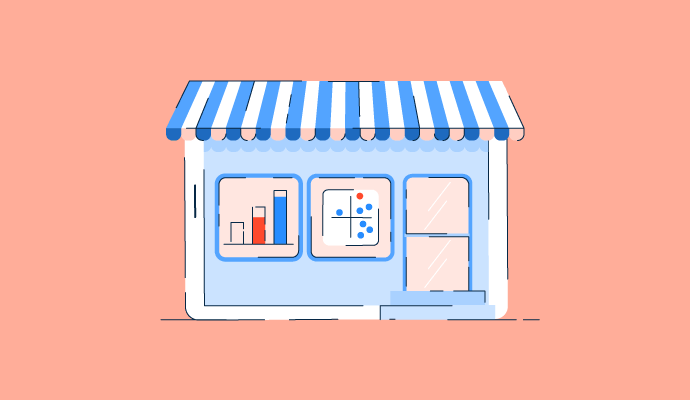November 12, 2025
 by Harshita Tewari / November 12, 2025
by Harshita Tewari / November 12, 2025

Another online launch, and your audience just scrolls past. No clicks, no buzz, no connection.
As digital fatigue sets in, even the most successful e-commerce brands are finding it increasingly difficult to break through. People want real experiences, not just screens. Brands need a way to show up in the physical world, build authentic connections, and make their products feel tangible.
And how do you do that? With a pop-up shop.
A pop-up shop is a temporary retail space that opens for a short period, typically ranging from a few days to several weeks. Brands use pop-up shops to test markets, launch products, or create buzz. These stores often appear in high-traffic locations like malls, festivals, or vacant storefronts.
Beyond marketing, pop-ups can also serve as a testing ground for physical retail. If sales are strong, they can help justify opening a permanent store.
Already planning one? Retail management software can help you run your pop-up like a pro, from staffing and inventory to real-time sales tracking.
Pop-up shops vary widely, from basic table displays to comprehensive mobile showrooms. Your selection should match your goals, budget, and target audience. Below are six common types along with guidance on choosing the best option for your needs.
A pop-up shop has many working parts. Depending on your vision, you may need to hire an experiential agency to create the experience you imagine. However, if you are setting up a pop-up shop on your own, here's a simple, 10-step framework to go from idea to opening day.
Planning the flow is one thing, understanding the logistics is another. Here are three major factors that impact the success (and cost) of your pop-up.
Of course, prices vary when totaling the cost of a pop-up shop, but below are a few factors you should consider when estimating the cost:
The shorter the duration of the pop-up, the lower the price. The type of pop-up can also affect the price. A sponsored event will be in part paid for, while an experiential pop-up will be entirely out-of-pocket costs for the shop.
Since the shop is only temporary, try to cut prices on the design and in-store hardware, as they don’t have to withstand wear and tear.
Tip: Don’t skimp on software that makes your shop more functional, such as retail POS (point of sale) software, which provides easy-to-use tools for employees and customers while completing transactions.
This may be the most important decision you make for your pop-up shop. You need to ensure the area you choose has a high volume of foot traffic while aligning with your brand's vibe.
You wouldn’t put a parka pop-up in Miami, and you wouldn’t put a swimwear pop-up during a Chicago winter. A good way to pick the right place is to determine where your customers already are. These are your biggest brand ambassadors, and they will spread the news more effectively than any marketing team could.
Once you narrow down your location or locations for the pop-up shop, you can pick a space. Choose from a pop-in store within a bigger retailer, a vacant storefront with temporary leases available, a mall, or even consider doing mobile pop-ups so you can take your store wherever you need.
This often-forgotten part of organizing your pop-up shop will ensure you are legally operating.
Licenses and permits differ per location, but generally speaking, you will need a license to sell and occupy a space and a business permit. If you’re selling food or alcohol, you’ll need to check for all the different kinds of permits required for that.
Lastly, you’ll need business or commercial insurance to protect your physical store, the goods inside, and your employees.
Before opening day, make sure you've covered these key steps. This list keeps your pop-up on track from planning to post-event follow-up.
Pre-launch planning
During the pop-up
After the pop-up
The end goal of a pop-up shop is sales. Money is the oil that keeps the machine going, but there are some other noteworthy benefits of opening a pop-up shop.
People want sensory experiences. It’s hard to trust, let alone buy, something you can’t touch or sample. Yes, e-commerce is convenient, but only after you know and trust a brand.
Pop-up shops provide an opportunity for you to engage with your shoppers. If you provide them with a memorable experience, they’ll come back for more and hopefully become brand advocates. Look into environmental graphic design options to make your pop-up store really pop.
The space's look and feel are only half the story. Be sure to train your employees to provide exceptional customer service.
If you create a buzzworthy shop, there will be lines down the block waiting to experience your pop-up. Pitch to local news publications to generate media coverage.
Going offline is a surefire way to gain media attention. Another way is through making it a shareable experience. Encourage people to take photos, tag you, and share them.
Not only is a pop-up shop a good test for new markets, but it’s also an opportunity to take advantage of the large offline retail market.
Pop-up shops may spike sales by invoking a sense of urgency in customers since they're only open for a limited time, encouraging people to make purchases on the spot. Also, the novelty and unique experience of a pop-up shop can attract more footfall and generate buzz, leading to additional sales. Who knows? Maybe your shop is meant to be offline. Test it here while increasing sales.
Pop-up shops have shorter lease terms and lower rent costs than traditional retail stores. This increased flexibility allows businesses to invest less capital while still benefiting from a physical retail presence. Pop-ups also require less inventory and fewer staff members, which further reduces costs.
Pop‑up shops can be high‑reward, but the “temporary” part doesn’t make them simple. Most problems come from rushing decisions or treating the pop‑up like a light side project instead of a real retail operation.
By incorporating the ideas given below, you can create a successful and memorable pop-up shop experience and leave a lasting impression on your customers.
Still got some questions? Dive into our FAQ section! We have covered some basic questions about building your own pop-up shop.
Anyone with a business idea or interest in selling goods or services can open a pop-up shop. All you need are the required resources and permissions. Some popular sectors for pop-up shops are retail, fashion and lifestyle, art, food and beverage, and health and beauty.
Planning a successful pop-up shop typically requires 3-6 months of preparation. You need to design the layout and theme, stock your inventory, and prepare retail displays. You may also need to hire assisted sales reps, which requires additional time for training. This timeline allows ample time to create a compelling pop-up experience and make a positive impression on customers.
When setting up your pop-up shop, staffing is crucial for managing day-to-day operations and customer engagement. However, temporarily relocating your entire team can be impractical and expensive, and neglecting staffing can compromise the success of your pop-up store. One solution is to hire a third-party staffing agency that specializes in experiential marketing. This will maximize your chances of creating an impactful in-store experience.
Absolutely. Many brands use QR codes, digital receipts, or mobile sign-ups to link in-person experiences to online offers.
Pop-ups offer a middle ground: more physical presence than e-commerce, less risk than a permanent lease. You get face-to-face interaction, faster customer feedback, built-in urgency, and offline brand visibility, without long-term overhead.
If you don’t have clear goals, strong inventory planning, or the time to promote it, a pop-up can drain resources. It’s also risky when margins are thin, or your target audience doesn’t shop in person.
Pop-up shops give brands a direct line to their customers. When planned with clear goals and executed thoughtfully, they offer a practical way to generate revenue, gather feedback, and increase brand visibility. Every decision,location, timing, staffing, and promotion shapes the outcome.
The more prepared you are, the more effective the experience will be. Treat it like a real retail launch, and the results will follow.
Ready to make smarter decisions? Explore retail analytics to gain a deeper understanding of your customers, streamline operations, and grow with confidence.
This article was originally published in 2019. It has been updated with new information.
Harshita is a Content Marketing Specialist at G2. She holds a Master’s degree in Biotechnology and has worked in the sales and marketing sector for food tech and travel startups. Currently, she specializes in writing content for the ERP persona, covering topics like energy management, IP management, process ERP, and vendor management. In her free time, she can be found snuggled up with her pets, writing poetry, or in the middle of a Netflix binge.
Customer experience has become one of the most important factors that determine the long-term...
 by Marilia Dimitriou
by Marilia Dimitriou
User-generated content (UGC) is no longer just a nice addition for brands.
 by Haley Fraser
by Haley Fraser
The surefire, tried-and-true trick to increasing your pop-up conversions is simpler than you...
 by Greg d’Aboville
by Greg d’Aboville
Customer experience has become one of the most important factors that determine the long-term...
 by Marilia Dimitriou
by Marilia Dimitriou
User-generated content (UGC) is no longer just a nice addition for brands.
 by Haley Fraser
by Haley Fraser


